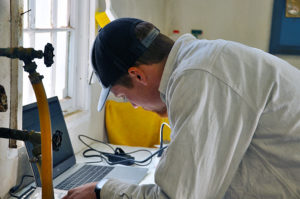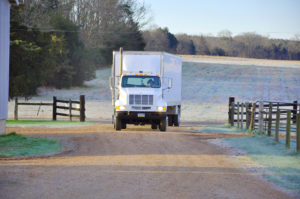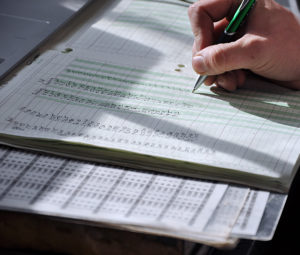 He uses a laptop, a printer and a laminator. But the newest face you’ll see at Maryland & Virginia doesn’t work in Reston – he brings those items to you and leaves you with a new milk tank calibration chart.
He uses a laptop, a printer and a laminator. But the newest face you’ll see at Maryland & Virginia doesn’t work in Reston – he brings those items to you and leaves you with a new milk tank calibration chart.
After the retirement of longtime tank calibrator Mike Kidd, Joe Weber of Newville, Pennsylvania became the co-op’s new tank calibrator. Weber started working in the industry by hauling milk for Barrick & Stewart Milk Hauling, a job which he still performs two to three days a week. The rest of his workweek is filled with his tank calibration schedule. On those days, he’s in his custom-built calibration truck, a retrofitted box truck, carrying around 2,500 gallons of water as well as the necessary hoses and pumps.
The calibration process is important since it is done only every seven years, roughly. Weber says many tanks that he calibrates have very few changes from previous calibrations. But if the tank settles into the ground or expands at all, it may change the readings.
“It’s important because we’re talking about people’s livelihoods and how they feed their families,” Weber said. “We want to make sure that the farmer is successful, and the cooperative is successful. That all starts right here at the farm with the milk in the tank and making sure that it’s read.”

The milk tank calibration process is simple, but takes precision, care and time. Weber communicates with the hauler and arrives soon after they have left with the latest load. With the tank empty, Weber begins by rinsing it out and fitting his equipment with the right adapters. He reviews the last calibration and any other data the member may have about the tank itself.
Next, Weber checks the equipment on his truck. Each time he goes to a new farm, he makes sure that his meter is working properly by using a prover tank to pump 50 gallons. Once confirmed, Weber then prepares to fill the milk tank for the first time. He begins at the first measurement point from the old chart, which may vary based on the tank.
 Milk tanks use either tubes or dipsticks to get measurement readings. If the tank uses a stick, Weber cleans it and dusts it to where he believes the reading will come to with his first water fill. After the tank has filled to that point, Weber inserts the stick and reads the measurement, which corresponds with a weight marker in hundredweight. Weber records both figures and begins to fill the tank further in 50-gallon increments, checking the measurements each time the fill stops. On larger tanks, Weber may increase to 100-gallon increments.
Milk tanks use either tubes or dipsticks to get measurement readings. If the tank uses a stick, Weber cleans it and dusts it to where he believes the reading will come to with his first water fill. After the tank has filled to that point, Weber inserts the stick and reads the measurement, which corresponds with a weight marker in hundredweight. Weber records both figures and begins to fill the tank further in 50-gallon increments, checking the measurements each time the fill stops. On larger tanks, Weber may increase to 100-gallon increments.
When each fill stops, Weber checks the stick for gallons and writes down its corresponding weight marker. He does this all the way up to the previous final fill marker in the tank’s historical chart. After recording the final reading, he prints and laminates a new chart to keep near the tank.
Weber is excited to be part of Maryland & Virginia and help members accomplish their goals. “I take a lot of pride in my job. Even though it’s a small part of what Maryland & Virginia does – and what dairy farming is – as a whole, I still think it’s important and I like what I do and I’m glad to be out here doing it. It means a lot to me.”
Weber works in conjunction with field representatives to schedule milk tank calibration. If you believe your tank needs a visit, reach out to your field representative.


